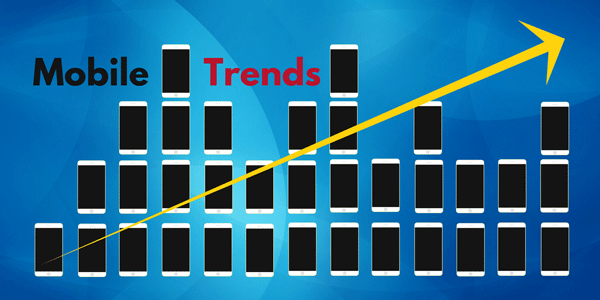Mobile compatibility is no longer something “nice to have,” it is a necessity. In fact, according to Gartner, more than half of all consumers will be using mobile devices first for anything they do online by 2018. If your business needs mobile visitors, are you prepared to meet the following new trends coming your way?
Consider this: 71 percent of total digital minutes come from mobile devices in the U.S. and it’s 91 percent as a comparison in Indonesia. Additionally, the average time in the U.S. browsing the desktop is 34 hours per month, which is small compared to the 87 monthly browsing hours on the smartphone. And, lastly, Google says 50 percent of search queries originate from mobile devices.
While searches can be broad, the “Food & Beverage” category nabs about 72 percent of that volume. These are just some of the statistics proving the power of mobile that Kimberly de Silva explores in her Entrepreneur article “9 Mobile Marketing Trends You Need to Know for 2018.” These trends are highlighted and summarized below.
Progressive Web Apps: The Next Big Thing for Mobile
If you haven’t heard about progressive web apps, a technology that combines the best of web and mobile apps to mimic an app experience without bringing the user to an “app store,” you’ll start hearing this term more in coming years. These are important because it encourages users to connect with your app right away. Instead of venturing off into the typical app route (find, download, open, use), which can lose about 20% of users with each step, progressive web apps cut down the steps. With progressive web apps, people can start using it right away without the downloading and installation steps. Then, once the user returns to the app, they can officially install it and “upgrade for the full-screen experience.” How big will progressive web apps be? By 2020, they are expected to replace “50% of general-purpose, consumer-facing mobile apps.” There will also be $1 trillion spent to make the web mobile-first by 2021.
Mobile Indexing: A Mobile First Shift
In late 2016, Google announced the shift to index websites based on mobile sites instead of desktop sites. In other words, your mobile presence is now responsible for how you show up. If you aren’t sure how good this is, let’s do a quick pop quiz. Do your pages load quickly? Do the buttons work on touch screens? Do your people need to zoom or side scroll to get the information they need? Are photos and text right where they should be? These answers will give you a health check, and quite possibly a course of action if you have some improvements to make!
Mobile Speed: It Needs to Be FAST
People today have busy lives and short attention spans. If your page takes more than three seconds to load, people are out of there. DoubleClick says this delay can result in a bounce rate of up to 53 percent. And, Think With Google reports, “If a page’s loading time goes from one second to five seconds, the bounce rate goes up by 90 percent.” Simply, invest in speed.
User Experience Smart Content: Make It Personal
Everyone wants to feel like you are talking to directly to him or her! Aberdeen research says that personalized email messages are pretty powerful; they improve click-through rates by 14% and conversions by 10% on average.
Magical Micro-Moments: The Phone Has All the Answers
When someone instinctively reaches for his or her smartphone to find something, this is called a micro-moment. A whopping 96 percent of users now rely on their phones for these moments. People are also “at least twice as likely to use search” when compared to other on- and off- line methods like social media or even store visits.
Artificial Intelligence: It’s Real
According to research, 80 percent of all marketing executives think artificial intelligence (AI) will “revolutionize marketing by 2020.” Furthermore, Tractica Projects predicts that more than 3.3 billion devices will have a virtual digital assistant by 2020.
Livestream: It’s Going Mainstream
If the future is indeed video, you don’t need to look too hard ahead to see the proof. As an example, video will account for about 78% of the world’s mobile data traffic by 2019. Facebook also points to the power of video; its users spend three times more time with videos than static content.
Mobile Payments: Positioned to Skyrocket
Enhanced mobile security has made the masses comfortable to use this online mobile payment, and people are embracing it big time. Here’s an amazing fact: By 2020, in-store mobile payments will reach $503 billion. Mobile wallets are even predicted to surpass credit/debit cards by 2020 here in the U.S.
Augmented Reality (AR) And Virtual Reality (VR): The New Reality Is Here
The enhanced customer experience through AR (augments current reality through things like clear visors that connect to smartphones) or through VR (completely transports the user away from reality and into another world through things like VR headsets) will become a much bigger part of our world. Experts predict AR and VR will “generate $67.3 billion in revenue by 2021,” a huge jump from the $2.3 billion in 2016.
Are You Ready?
What mobile trends are you already incorporating into your business? What is on the horizon? Will mobile be a huge part of your 2018?
This article is made possible by Checksforless.com. For more than 35 years, Checksforless.com has provided over 500,000 businesses with high quality business checks, deposit slips, and other banking supplies with easy ordering and fast production times; all at the guaranteed lowest price in the nation. Our discount business checks are easily customizable and compatible with over 4,500 software programs including QuickBooks® and Peachtree/Sage®. Email or call us toll-free at 800-245-5775.
References:
https://www.smashingmagazine.com/2016/08/a-beginners-guide-to-progressive-web-apps/
https://www.entrepreneur.com/article/306923
